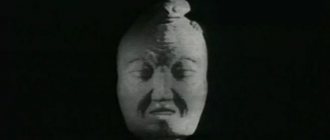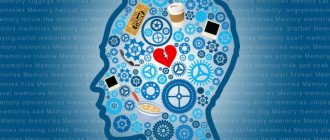© Narrated by Andrey Arkadyevich Shmilovich
, Doctor of Medical Sciences, doctor of the highest category, head of the Department of Psychiatry and Medical Psychology, Russian National Research Medical University named after. N.I. Pirogova, chief physician of the Alter clinic:
Today in the series on comparative age aspects of mental disorders we will talk about mental disorders of childhood
.
We will talk about pre-pubertal age, that is, up to approximately 10–12 years, during which the child goes through several stages of his psychophysical development. This is a very important age from the point of view of the development of his mental functions, his personality, and character. This age also has its most significant periods. They are distinguished by the special vulnerability of the child’s psyche to external social, sometimes pathogenic factors. These periods of particular vulnerability are called age-related crises.
In childhood, age-related crises are well known to psychiatrists, psychologists, and teachers - these are the ages of 3 years and 7 years.
Formation of the first communication connections
At the age of 3, the child finds himself on the threshold of kindergarten. When, on one of the joyful days of September 1, his mother takes him to some strange institution, in which for some reason he must be without his parents for quite a long time, surrounded by very strange people who are similar to him, and even some kind of aunt , calling herself “the educator,” demands that he fulfill the requirements that are necessary.
This age is very important from the point of view of the formation of the child’s first communicative connections with peers. It is at this age, at 3 years old, that the first rudiments of role identity appear. The child begins to recognize himself as an individual and identify himself as an individual, separate from those around him. Finds in himself those traits that are not in others, and finds in others those traits that he does not have. He begins to understand the difference between himself and others, the first signs of his individuality are formed.
This is a very important period, and personally, I categorically do not advise ignoring preschool institutions, kindergartens, sports sections, clubs, where the child has the opportunity to develop a sufficient number of communication skills.
Children at home who sit with their grandparents around the clock and only go out in good weather to the sandbox in the yard are much less well adapted to school than those children who in preschool age had the opportunity to establish communicative connections and form their social role.
Stigma and refusal to treat
The relatives of Sasha and Christina (names have been changed - TD's note) are united by denial of their diagnoses and refusal to begin full-fledged treatment. Symptoms of the disorder are noticed only when they get worse (during depressive episodes), but they do not discuss their internal problems with their family. Why this scares them so much is also not directly stated.
Christina's father has bipolar affective disorder (BAD). The girl learned about him while studying at the university. Then their family was going through a difficult period: problems with money and work, and there was the question of moving. It was the father who provided for the family and blamed himself for what happened. At some point he could not stand it and tried to commit suicide. Relatives saw marks from the rope on his neck. After consulting, we decided to send him to a military sanatorium, where he was diagnosed.
Neurotic disorders of childhood
During this period, the child is stressed, he may have a large number of various types of neurotic disorders. And we know these disorders well. enuresis may suddenly appear
– urinary incontinence, we can observe bitten nails in these children. These children may experience a large number of fears; they refuse to sleep in a separate room with the lights off; even if they are forced to sleep in the nursery, they still find the opportunity to sneak into their parents’ bedroom at night and crawl under their blanket.
These children very often develop behavior problems
in case they face quite a lot of stress factors. And kindergarten teachers pay attention to these behavior problems. Sleep disturbances, bad mood, tearfulness, capriciousness, loudness, sometimes excessive demonstrativeness, posturing may appear - we call all this childhood neuroses or childhood neuroses.
Children do not display such neurotic symptoms as we are used to seeing in adults, because their affective emotional sphere has not yet matured, and they cannot experience this or that difficult life situation the way adults do, so most often they react with their bodies.
Children have a very developed psychosomatic reaction
. Their neuroses, as a rule, are of a somatic nature. As I already said, enuresis is one of the types of childhood neuroses. There is also stuttering - this, too, in 90% of cases is attributed to the psychological neurotic problems of the child. This also includes various kinds of conditioned diseases; most likely, they can be found in the form of symptoms from the gastrointestinal tract. Children may experience pain symptoms that are not confirmed by examinations.
Sometimes children experience what is called aspiration syndrome.
, when at the moment of just such another violent emotional reaction they suddenly begin to choke, they experience bronchospasm, the question arises that perhaps this is bronchial asthma. Well, and many, many other such polymorphic, unusual things that happen to children precisely during their age-related crises.
Children's grief at the loss of loved ones
Children, like adults, always experience the loss of a loved one. In general, children's grief is characterized by such features as delay, hiddenness, surprise, and unevenness. The child may not show immediate grief, and the acute reaction is sometimes delayed for months. In some cases, real awareness and experience of loss comes very late and under the influence of some significant event, for example, another loss. The child may not show overt signs of grief, such as crying or verbally expressing emotions, but may show signs of hidden bereavement in the form of actions, behavior changes, and neurotic symptoms. The open expression of a child's grief sometimes turns out to be unexpected for those around him: the child was just playing, frolicking, and suddenly “breaks into tears.” It is noteworthy that in children, grief often has a wave-like character, when a surge of emotions and a stream of tears are replaced by relative calm or even animation and moments of fun. Children experience grief very unevenly and tend to express their sadness sporadically over a long period of time.
The reaction of children to the death of a loved one often remains a sealed secret for adults. It happens that a child’s reaction to a loss shocks those around him or, at a minimum, leaves them bewildered. And sometimes adults don’t even know whether the child is experiencing loss, and if so, how exactly he is experiencing it. Moreover, it is not clear how to help him.
Parents of bereaved children typically face questions such as:
- Should I tell my child about the death of a loved one or not?
- should he be included in the family mourning process and funeral arrangements or not?
- Should I take it with me to the funeral or not?
- to remember the deceased with the child or not?
Contacting a child psychologist will allow parents not only to prevent the undesirable consequences of loss for the child, but also to achieve certain positive results.
Problems of school maladjustment
There is also a 7-year-old crisis. This is the age when a child starts school. And here he gains even more independence, here he begins to understand what responsibility is, begins to receive the inclinations of ideas about legal capacity, that is, the idea that his actions have some consequences, and these consequences are connected specifically with him.
At this age, the child is also quite vulnerable. First-graders can stumble already in the first months of school, we call this the problem of school maladaptation
. They are unable to establish connections with classmates, constant disagreements arise with the teacher, they refuse to go to school, they throw tantrums right in class, interfere with everyone’s learning by getting up from their seats, not realizing that they are not allowed to walk around the class. The reaction of teachers means nothing to them; this leads to a serious conflict with many participants in the school process, not only with classmates and teachers, but also with the school principal. And parents are also starting to take part in this.
Many parents take the child’s side, considering him undeservedly offended. They see the problem in the incompetence of teachers and begin to blame teachers, often adding fuel to the fire of these neurotic symptoms and behavioral disorders that I have already mentioned.
Early mental illness. Mental retardation
In addition to neurotic disorders, quite serious mental illnesses can also begin in childhood, among which today, perhaps, we can classify two diseases as the most common of all other mental disorders of childhood.
The first disease is called mental retardation
. Unfortunately, it happens quite often. If we are talking about severe forms of mental retardation, then it attracts attention even in the first years of life. If we are talking about its mild or borderline forms, then this only manifests itself when the child goes to school, and from the first days he does not keep up with his peers in mastering the material.
Mental retardation can be different; there are many reasons for its occurrence. Among them are many different kinds of neurological or therapeutic, pediatric diseases that the child suffers from very early infancy. Or which started a little later. These include traumatic brain injuries, and some kind of neuroinfections, perhaps some kind of genetic, hereditary, chromosomal pathology, which leads to underdevelopment of the central nervous system and, accordingly, to mental disorders in the form of mental retardation.
Children with mental retardation are more vulnerable to neurotic symptoms, since in the case of mild mental retardation they understand and realize the fact of their inadequacy and see how they lag behind their peers. And they very often find themselves at the center of so-called bullying. Peers begin to mock them, painfully making fun of their odd behavior.
In these situations, when we are dealing with mental retardation, it is very important to promptly resolve the issue of the form of education, to what extent this form in a regular comprehensive school will be comfortable for the child himself if he does not have time there. And how much easier it will be for him to study in a school where the requirements for the educational process are somewhat different, and they are close to the individual, as we say, Waldorf requirements.
Mental disorders and behavioral disorders in childhood and adolescence. Tables
1. Motor restlessness, restlessness: children often move their arms and legs, twist their heads, fiddle with things and clothes, fidget, spin, shift, trample, grimace, perform unnecessary actions with objects, stand up repeatedly, wander around the room, etc. Some children are restless even in their sleep, constantly toss around in bed and can fall out of bed more than once during the night. When walking, children often rush, break into a run, and get ahead of their companions. Excessive mobility may be absent for some time if the child is watching an exciting television program, is engrossed in a game, or is absorbed in some kind of spectacle, but it increases significantly if he has to do homework or anything else that requires concentrated active attention. It is less noticeable in structured situations that require certain behavior than in free, unstructured ones.2. Inability, upon request or in play, to remain still or motionless for more than 3–5 seconds
3. Constant distraction of attention to external, secondary stimuli that are not important in the context of a given situation
4. Impatience, such as inability to wait one's turn in games, group activities, inability to delay gratification, need for immediate gratification
5. Inability to think about answers to questions, answers out of place, given by the first thought that comes to mind, often the question itself is not heard
6. Difficulty in following instructions from outside (not due to the desire to contradict or misunderstanding, but due to the fact that patients cannot concentrate and listen carefully to the instructions of adults)
7. Inability to maintain attention for a long time when performing a specific task or playing activity
8. Inability to see things through to completion
9. Inability to remain silent in the game, often increased talkativeness
10. Difficulties in maintaining a dialogue: does not listen to what the interlocutor is saying, interrupts someone’s conversation, interference in outside conversation
11. Children often do not listen and ignore something said to them.
12. Things needed to complete a task are often lost or forgotten where they were left.
13. Carelessness, frequent falls from heights, into holes, into water, increased susceptibility to injury
14. Emotional instability, frequent mood swings, easy transitions from laughter to tears, sometimes depression, pointless anxiety, fussy restlessness (“body anxiety”)
15. Impulsivity, unpredictability in behavior, a tendency to act without thinking about the consequences of one’s behavior, which can lead to reckless or even dangerous actions.
16. Carelessness, carelessness, sloppiness
17. Lack of concentration, disorganization, inability to plan, maintain order and discipline. When communicating with adults, patients are often too familiar or even cheeky, impudent; due to the characteristics of their behavior, they are often rejected by their peers
18. Irritability, touchiness, aggressiveness (in 75% of patients)
19. There is often a general lack of coordination, a decrease in memory and mental abilities (IQ in many patients is below 100%, perseveration, literal thinking, its concreteness or inability to take into account the context of what is happening), specific impairments in learning abilities (reading, writing, arithmetic), are observed. developmental disorder of speech articulation, defects in the development of hearing and vision, equal use of both hands (absence of a dominant hand), rapid alternating movements, unclear signs of residual organic failure of the brain, sleep disturbances, appetite, the phenomenon of vegetative dystonia, changes in electrical activity on the EEG and a tendency to development of antisocial personal qualities
20. Secondary psychological disorders are common: decreased self-esteem, feelings of inferiority, self-doubt, depressed mood, tendency to self-blame, self-torture, withdrawal from classes, hypercompensatory behavior (deceit, bragging, etc.)
21. There is often a negative attitude towards patients on the part of parents, teachers and educators, especially if they perceive the patients’ behavior as spoiled, bad manners or a tendency to hooliganism
22. The course of the disease is chronic; remissions up to 12 years are usually not observed. After 12 years, patients gradually become calmer, and somewhat later their indicators of active attention improve. In 20% of patients, signs of the disorder may persist indefinitely
Autism Spectrum Disorders
The second most common mental disorder in childhood is autism spectrum disorder. Abbreviated as RAS. The structure of these disorders includes many different types of clinical units. One of the most striking and classic manifestations of autism spectrum disorder was described at one time by the domestic psychiatrist Grunya Efimovna Sukhareva and her foreign colleague Hans Asperger.
This form is now called Asperger's syndrome.
, that is, early childhood autism syndrome, in which a rather pronounced asynchrony of the child’s mental development occurs. In his development, we see a significant acceleration in relation to peers of intellectual, cognitive functions, and to a significant extent a lag in relation to emotional and volitional functions.
The personality of such a child is formed in a deformed way; he ultimately finds himself deprived of the mental capabilities for communication with peers. He has no choice but to withdraw into his own inner world, which is called the “autistic world.” Autistic world
- this is the world of his fantasies, attitudes, known very often only to him. Help for such a child can only be provided by a specialist who has managed to at least somehow look into this world, not to mention getting into this world and understanding its laws.
Characteristics of mental disorders in childhood
Yulia Oblavatskaya
Characteristics of mental disorders in childhood
DISORDERS IN CHILDREN . PSYCHOLOGICAL CHARACTERISTICS OF PSYCH . DISORDERS IN CHILDHOOD
V.V. Lebedinsky identifies six main types of mental development disorders in children :
• Irreversible mental retardation (oligophrenia)
.
• Delayed mental development (reversible - fully or partially)
.
• Damaged mental development - dementia (the presence of a previous period of normal mental development ).
• Deficient development (in conditions of visual impairment, hearing impairment, somatic pathology)
.
• Distorted mental development (early childhood autism )
.
• Disharmonious mental development ( psychopathy )
.
Underdevelopment (oligophrenia)
— early stage of damage to the central nervous system; Y the child’s development occurs on a defective basis, the child is physically healthy; all neuro-Y and some somatic functions are underdeveloped, sensory, motor skills, elementary emotions are not fully developed, the HMF and the personality as a whole are underdeveloped. Violation reproduction, motor skills, attention, speech, thinking, emotions: poverty, slowness, insufficiency of gnosis, praxis, speech, emotions, memory manifests itself less than underdevelopment of thinking, i.e. underdevelopment of higher forms is the main symptom of Y underdevelopment. Underdevelopment of thinking hinders the development of all other processes.
Impaired Y development (organic dementia)
.
disintegration of HMF. Causes: infections, injuries, intoxications, metabolic disorders, etc. Arises or progresses at the age of 1.5-3 years.
According to the dynamics of the disease process, they are distinguished -
a) residual dementia (dementia is caused by residual effects of brain damage, trauma, infection, intoxication);
b) progressive dementia (caused by ongoing organic processes, perhaps hereditary diseases).
Arrested Y development (RDD)
. Slowing down the rate of formation of cognitive and emotional spheres with their temporary fixation at earlier stages of development. Types of mental retardation according to etiological principle:
1. ZPR of constitutional origin. The emotional-volitional sphere is at an earlier age level .
2. ZPR of somatogenic origin is caused by long-term somatic insufficiency, Y development is inhibited by persistent asthenia, which reduces Y tone. Children are timid, insecure, fearful, and capricious.
3. ZPR of psychogenic origin . Associated with improper upbringing conditions.
4. ZPR of cerebral origin. The delay in the emotional-volitional sphere is very pronounced. The etiology is associated with organic failure of the nervous system.
Deficient development (cerebral palsy, ODD, hearing, vision)
- associated with primary failure of individual systems - vision, hearing, musculoskeletal system. A primary defect in the analyzer or a certain somatic system leads to underdevelopment of the functions most closely associated with them, as well as to a slowdown in a number of others that are indirectly related to the victim. Common to any type of developmental deficiency is the uniqueness in the development and formation of personality. The latter can manifest itself both as a consequence of the main defect, which makes it difficult to have full contact with peers and other people, and as a result of improper upbringing. According to L. S. Vygotsky, any physical defect, be it blindness, deafness or mental retardation, is realized as socially abnormal behavior. A kind of social dislocation is formed. The attitude of the surrounding people towards the defective child changes, and his attitude towards the world around him also changes. The main task of correctional pedagogy is to correct social dislocation.
Distorted Y development (early childhood autism - EDA )
- a complex combination of general underdevelopment, delayed, damaged and accelerated development of individual HMFs. Violation of social child development, desire for constancy, manifestation of stereotypical movements, resistance to changes in the environment;
speech delay and impairment; early manifestation (up to 2.5 years)
Y development pathologies. Causes: congenital abnormal constitution; organic disorders of the central nervous system; congenital metabolic disorders; early onset schizophrenic process. Not exactly known.
Motor skills: motor stereotypies, delayed walking or sudden transition to walking.
Intelligence: poor concentration, quick satiety, a large store of knowledge for his age in certain areas, likes to listen to readings, poetry, responds better to whispers, does not talk about himself in the first person.
Disharmonious Y development ( psychopathy )
—
Psychopathy is an anomaly of character , occurring in the disharmony of Y personality traits and the inadequacy of its reaction to external stimuli from which the person himself or society suffers. Violation of the emotional-volitional sphere. The core group of these conditions consists of the so-called constitutional psychopathy , usually of hereditary origin. This includes schizoid, epileptoid, cycloid, psychasthenic and, to a large extent, hysterical psychopathy . Most psychopathy develops as clinically pronounced variants in adolescence and adulthood .
Psychological and pedagogical characteristics of children with mental retardation (MDD)
Based on the etiological principle, K. S. Lebedinskaya identified four main options for mental :
1. delayed mental development of constitutional origin;
2. delayed mental development of somatogenic genesis;
3. mental retardation of psychogenic origin ;
4. mental of cerebral-organic origin.
The syndrome is based on a delay in the rate of mental development and uneven underdevelopment of intelligence.
Caused by an unfavorable course of pregnancy with prolonged oxygen starvation of the fetus and intrauterine growth retardation, asphyxia during childbirth, birth trauma, infectious, hereditary diseases of the central nervous system, defects of the sensory organs (blindness, deafness, severe somatic diseases and intoxication at an early age . May be associated with sensory and emotional deprivation (the phenomenon of hospitalism, improper upbringing (neglect and extreme degree of pedagogical neglect)
.
It manifests itself in borderline intellectual failure, with the general preservation of higher mental functions . The preconditions of intelligence suffer the most: scattered and unstable attention, insufficient voluntary memory, weak mental activity , rapid exhaustion under mental stress. There is low cognitive motivation, weak volition in educational activities, but at the same time, unlike mental retardation, the ability to learn is preserved. Such children are characterized by limited and fragmented ideas about the world around them, naivety, suggestibility and increased dependence on other people. They prefer manual labor and mechanical, visual, concrete activities in which they are easier to achieve success.
In cases of mental retardation of constitutional origin, mental infantilism often corresponds to an infantile body type with childish plasticity of facial expressions and motor skills. The emotional sphere of these children is at an earlier stage of development, corresponding to the mental makeup of a child of an earlier age , but there is no lag in the intellectual sphere.
Somatogenic mental retardation is characterized by emotional immaturity, which is caused by chronic diseases, congenital and acquired somatic defects. In slowing down the pace of mental development, a significant role is played by persistent asthenia, which reduces general and mental status . Such children are characterized by a decrease in cognitive activity with primarily intact intelligence.
Delayed mental development of psychogenic origin is associated with unfavorable upbringing conditions, that is, it has social causes. In conditions of neglect, for example, the pathological development of a person with mental retardation can be formed according to the type of mental instability (inability to regulate emotions and desires)
.
In conditions of overprotection, psychogenic mental manifests itself in the formation of egocentric attitudes, passivity, lack of purposefulness and independence.
With gross authoritarianism, children experience neurotic personality development. Mental retardation of cerebral-organic origin is similar to mental retardation, since it is also based on organic damage to the brain in the early stages of development. This form of mental retardation is characterized by underdevelopment of cognitive activity, but the fundamental difference from mental retardation is the possibility of pedagogical correction of this condition.
Children with mental retardation entering school have a number of specific characteristics. They are not quite ready for school. They have not developed the skills and abilities necessary for learning; they do not have enough knowledge to master the program material. They are not able to master counting, reading and writing without special help. It is difficult for them to comply with the norms and rules of behavior accepted at school. They experience difficulties in voluntary organization of activities. These difficulties are aggravated by the weakened state of their nervous system - they experience nervous exhaustion, which results in rapid fatigue, low performance, and refusal to carry out activities that have already begun. These children often have headaches.
In children with mental retardation, decreased performance and instability of attention manifest themselves depending on their individual characteristics. In some children, the highest level of attention tension and performance is detected at the beginning of the task and decreases towards the end of the work; for others, the greatest performance occurs some time after the start of work (i.e., they need a period of working in)
; Still others experience periodic fluctuations in attention and performance throughout the task.
The attention of children with mental retardation is characterized by instability , increased distractibility, and insufficient concentration on an object. Lack of attention negatively affects the processes of sensation and perception. Children with mental retardation have a lower level of perception compared to the norm. Significant disadvantages of perception are the slow pace of processing the information the child receives and impaired search functions. Particularly noteworthy are the shortcomings of spatial perception, which is formed in the process of interaction of vision, motor analyzer and touch.
The study of the memory processes of such children showed their lack of productivity, small memory capacity, inaccuracy and difficulty in reproduction. Therefore, it is necessary to specifically intensify the cognitive activity of schoolchildren with mental retardation by increasing motivation and focusing students’ attention on the task.
Children with mental retardation have a delay in the development of all forms of thinking. By the beginning of school, they, as a rule, have not formed the basic mental operations - analysis, synthesis, comparison, generalization. This is clearly manifested when they solve arithmetic problems and master reading and writing skills.
Children with mental retardation are characterized by a reduced level of cognitive activity, which is manifested in their lack of curiosity - some do not ask questions at all, while others ask questions relating only to the external properties of objects and phenomena.
Oral speech in children with this developmental pathology contains minor violations of both pronunciation and grammatical structure. Their phonemic hearing and phonemic perception are insufficiently developed, and their vocabulary is poor. The logical construction of related statements is disrupted. There is a tendency to get stuck on minor details, miss an important logical link, and disrupt the transmission of the sequence of events. Such children easily slip from one topic to another.
In written speech, children with mental retardation make a number of specific errors that may be caused by insufficient development of the lexico-grammatical aspect of speech; associated with underdevelopment of sound analysis; reflect the immaturity of phonemic hearing. Children have difficulty learning the rules for identifying sentence boundaries. But all these features of the speech development of children with mental retardation can manifest themselves unevenly and to varying degrees: [3, p. 107].
The educational motivation of children with mental retardation is absent or extremely weak, and there is no positive attitude towards school. The leading activity for them remains play. By the beginning of systematic education, children with mental retardation have not developed the highest form of play activity - role-playing game, which prepares the child to perform a new type of activity - educational. Even when play is organized by adults or normally developing peers, these children are not always able to fulfill the role they have taken on, move from one role to another, or engage in imitation.
Children with mental retardation are often mistakenly considered mentally retarded. There are some features that help distinguish children of these groups. In children with mental retardation, difficulties in mastering basic literacy and counting are combined with relatively well-developed speech, a significantly higher ability to memorize poetry and fairy tales, and a higher level of development of cognitive activity. is not typical for mentally retarded children .
An important difference between children with mental retardation and mentally retarded children is that stimulating the activities of these children and providing them with timely pedagogical assistance allows us to identify their zone of proximal development, which is several times greater than the potential capabilities of mentally retarded children of the same age : [4 , With. 197].Children with mental retardation are always able to use the help provided to them in the process of work, learn the principle of solving a task and transfer this principle to the performance of other similar tasks, that is, they can subsequently perform independently what they are currently doing with the help of a teacher.
Children with mental retardation actually drop out of the educational process if correctional and developmental work is not carried out with them. Such children need specially organized correctional and developmental education, which can be carried out in special boarding schools or in special (correctional)
classes of VII type at secondary schools.
Consultation with a clinical psychologist , psychoneurologist or child psychiatrist . Treatment aimed at strengthening and stimulating the development of the neuropsychic sphere : apilak, Eleutherococcus extract, stinging nettle infusion, B
(especially B6, drugs that improve blood supply to the brain
(dosages and timing of administration as directed by the attending physician)
. The diet requires honey, lemon, carrots, garlic, wild strawberries and blueberries
(if there are no allergic reactions)
. Back massage. Hot foot baths with teaspoon of dry mustard.In education, it is necessary to teach the child to think, with an emphasis on the development of curiosity, attentiveness and orientation functions (the ability to see, observe and understand, encourage hard work and independence, form the habit of completing things started.
Psychological and pedagogical correction is aimed at intensive and painstaking training of learning ability: first, the child completes the task together with an adult, delves into the logic (principle)
solves the problem, then tries to independently apply the experience gained.
The corrective effect depends on the timely detection of developmental delays and the beginning of classes to overcome it. Questions about the timing and curriculum at school
specifically addressed Psychological and pedagogical characteristics of children with speech disorders
Children with speech disorders usually have functional or organic abnormalities in the central nervous system. Due to organic brain damage, children do not tolerate heat, riding in public transport, or swinging for long periods of time; complain of headaches, nausea and dizziness. Many of them exhibit various motor disorders (impaired balance, coordination of movements)
.
Such children get tired quickly; characterized by irritability , increased excitability, and motor disinhibition.
They are emotionally unstable, the mood of such children changes quickly, and can be aggressive, intrusive, and restless. They may experience lethargy and lethargy, but much less frequently. It is difficult for such children to maintain perseverance, efficiency and voluntary attention throughout the entire lesson. They may exhibit motor restlessness: during the lesson, walk around the classroom or run out into the corridor. During recess, these children are overly excitable, do not respond to comments, and after recess have difficulty concentrating on the lesson. Typically, such children have instability of attention and memory, especially speech, a low level of understanding of verbal instructions, insufficiency of the regulatory function of speech, a low level of control over their own activities, impaired cognitive activity, and low mental performance.
The mental state of these children is unstable, and therefore their performance changes dramatically. During a period of psychosomatic well-being, such children can achieve fairly high academic results.
Children with functional abnormalities in the state of the central nervous system are emotionally reactive, easily give neurotic reactions and even disorders in response to a remark, a bad grade, or disrespectful attitude from the teacher and children. Their behavior may be characterized by negativism , increased excitability, aggression, or, conversely, increased shyness, indecisiveness, and fearfulness. All this as a whole indicates a special state of the central nervous system of children with speech disorders: [1, p. 254].
Psychological and pedagogical characteristics of children with movement disorders
Most often these are children with scoliosis, congenital dislocations of the hips, club feet and cerebral palsy. The main manifestations of motor disorders in them are unsteady walking, a slow pace of walking, and the inability to independently go up and down the stairs. Such children find it difficult to dress, undress, tie a bow, fasten a button, etc. without assistance. These difficulties are most pronounced in children with cerebral palsy. Their right or left hand may be affected, and they cannot perform actions with the affected hand. There is a lack of coordination of movement: they walk on their legs widely spaced , their gait is extremely unstable, and if they are frightened or excited, they may fall. Self-care skills in these children are most often not fully developed, practical activities are extremely limited, and they are not ready to master drawing and writing skills.
Children with cerebral palsy often have incorrect pronunciation of certain sounds. Such children are deprived of the opportunity to move freely and manipulate objects, their communication is limited, and therefore, by the beginning of school, they cannot acquire the stock of knowledge and ideas about the world around them that their normally developing peers have. Information about the environment is often formal ; it is fragmentary and isolated from each other. Most children slowly develop operations such as comparison, identifying essential and non-essential features, establishing a cause-and-effect relationship between objects and phenomena of the surrounding world, which results in a poor stock of knowledge and ideas, inaccuracy of existing concepts, and limited active and passive vocabulary. Lack of knowledge and ideas about the world around us is often a consequence of the fact that the child simply did not encounter many life events and phenomena due to forced isolation.
A prerequisite for the successful adaptation of a child with cerebral palsy to a public school is the establishment of close contact and cooperation between the teacher and parents.
Psychological and pedagogical characteristics of children
with psychopathic forms of behavior
Problems in the behavior of such children can be caused by both biological and social factors. In this case, biological factors should be taken into account only as starting points. They are not decisive in the process of forming a child’s personality. The degree of psychopathic state largely depends on the conditions under which his development takes place. With the right pedagogical approach and favorable social conditions, psychopathic behavioral characteristics of children can be completely compensated. If the development of a psychopathic child proceeds in unfavorable conditions, he may experience significant pathological disturbances in character and behavior .
In psychopathic children, with full mental development, underdevelopment and peculiar changes in the emotional-volitional sphere are observed. Some children are characterized by high excitability, combined with pronounced extroversion, suspicion, anger, stubbornness and pedantry. In behavior they are prone to cruelty, vindictiveness, extremely demanding of others (with epileptoid psychopathy )
.
In other cases, children are characterized by pathological isolation, weakness of emotional attachments up to callousness, and pronounced difficulties in establishing informal communication. At the same time, children demonstrate a tendency to intellectual activity (with schizoid
psychopathy ) .
In some cases, there is egocentrism, overestimation of one’s capabilities, and emphasized self-affirmation, which often leads to conflicts with others. Such children often exhibit increased excitability and a tendency to affective outbursts. characterized by underdevelopment of the will, which leads to increased suggestibility and unstable mood. Their behavior may be impulsive ( with unstable
psychopathy ) .
Children with psychopathic traits have reduced performance, they are not attentive enough, cannot concentrate, and are not able to overcome difficulties in the learning process: [2, p.
98]. In the course of correctional pedagogical work, it is very important to prevent the possibility of gaps in knowledge, since pedagogical neglect will significantly complicate further work with such children. Instilling intellectual interests in psychopathic children is of great importance. This increases the efficiency of educational work and helps to inhibit existing primitive drives.
Correctional and educational activities with children of this group should include types of work that would be aimed at developing the ability to analyze and correctly evaluate their actions. Considering that these children do not have enough control over their behavior, show instability, are suggestible and easily fall under negative influence, the teacher must constantly place them in a strictly organized regime and not let them out of sight. When working with these children, it is very important to maintain a calm, even tone, since they are easily excitable, often irritated and reach an emotional outburst over the most insignificant reason. At the same time, the teacher must remember that during a period of passion it is better to switch the child to some other activity than to persuade, let alone punish him.
Parents need to patiently, using playful forms, teach their child life skills, model situations of overcoming feasible difficulties, cultivate independence and positively reinforce successes. Encourage interaction with peers (rather than younger children)
.
The issue of the child’s readiness for school and the start date of education specifically considered
Atypical childhood autism
In addition to Asperger's syndrome, autism spectrum disorders also include other variants: Kanner's syndrome, Geller's syndrome - this is the so-called atypical childhood autism. We begin to talk about atypical childhood autism when, against the background of autistic manifestations, some psychopathological phenomena begin to appear in a child, indicating to us the onset of some kind of mental illness. For example, he begins to have some hallucinations, or he becomes so detached from what is happening that he generally stops reacting to what is happening around him and “freezes” - this is the so-called catatonia syndrome. However, a complete picture of mental illness does not emerge. And these symptoms are ultimately reversible.
We must remember that early childhood autism and all autism spectrum disorders are a very ambiguous group in prognostic terms. In particular, there are options that have a fairly favorable prognosis; literally, all manifestations of autism completely disappear with age and appropriate treatment. At the other pole are those forms of childhood autism that, with age, unfortunately transform into current mental illnesses, more typical of adolescence or adulthood.
Onset of adult mental illness. Childhood form of schizophrenia
In addition, in childhood we can, unfortunately, observe the onset of adult mental illness. It is rare, however, that childhood forms of schizophrenia
. Its course is usually very difficult, unfavorable and malignant. In these cases, the child finds himself at the mercy of very severe painful symptoms when he hears voices or sees some visual images that cause him certain fears. When he, being in this psychotic state, hides from these ghosts, which seem very dangerous to him and are present somewhere nearby.
It is practically impossible to establish any contact with this child on a verbal level. The only way to help is to hospitalize him in a children's psychiatric hospital. Such hospitals exist; they specialize specifically in childhood mental illnesses, when specialists in this case have experience working specifically with children.
Favorable treatment prognosis
There are also many other mental illnesses, it is almost impossible to cover everything. The only thing that needs to be said is that children with certain mental disorders, as a rule, are treated quite well, that is, it is sometimes possible to achieve much greater results with them than with adults. But only under one condition: if their relatives, especially parents, who are extremely concerned about the health of their child, agree with psychiatrists that their beloved child needs the help of a child psychiatrist.
Child psychiatry, as a rule, uses not only medical, that is, purely psychiatric technologies, with medications or some other methods of treatment. Psychologists are mostly involved in child psychiatry. Family psychologists conducting group psychotherapy, teachers, various kinds of educators, defectologists, speech therapists, and pediatricians participate in the provision of assistance. As a rule, this is a whole multi-professional team that takes on the child’s health and which jointly solves various aspects of his problem.
Seeking medical help in such a situation will greatly facilitate the task of diagnosis, since in child psychiatry there are many methods, including very accurate, almost 100% methods for diagnosing certain mental illnesses.
For example, genotyping is very widely used, when we can with a high degree of probability diagnose a particular disease associated with a mutation or genetics. The main thing is that the child is in the field of view of specialized specialists. The main thing is that he receives the medical care he needs on time in order for his future life to be healthy.









